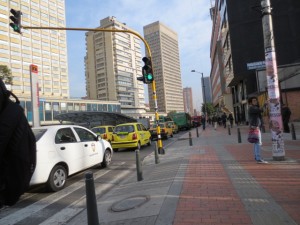In my first weeks here, much of my time has been focused on family, as my wife Peggy and I help our three kids (ages 5, 8, and 12) get settled in emotionally and culturally into a new life that is unfamiliar to them. This includes navigating the effects of their culture shock and incomprehension of what people are saying to them in their daily interactions (they don’t speak much Spanish yet), as well as getting them started and settled in their schools–a preschool for the youngest and Spanish language school for the older ones. It also includes moving from Burlington, Vermont, an small-scale and intimate city where we walk and ride bikes most places–and can mostly take our safety in public space for granted–to an enormous city where traffic is usually pretty horrible and distrust of public space is the norm. It has been at times exhilirating and other times frustrating and difficult.
Some of our difficulties and tensions have emerged around getting to and from places; moving five people of different ages under any conditions in a large city is a challenge. Of course, we’re not alone, and it’s striking how much getting places consumes time, money, and emotional energy here. Indeed, it’s fair to say that one of the central concerns of peoples’ lives here, aside from having a place to live and a job or some other means to make money, is how to get to and from the places that are important or necessary in their lives. And it’s not easy–people often live distant from those places, and the infrastructure and social experience of moving around can be difficult and frustrating. Among the first things I’ve heard people comment on when you see them is how bad the traffic was, how crowded the buses were, or how unpleasant was the experience of getting there. One woman I know travels about 2 hours each way to get from her home to her place of work. Both are in the northern part of the city and as the crow flies less than twenty miles. But the circuitous bus routes and terrible traffic make it long and arduous. Her commute is not unusual in this city; she is one of literally millions who have similar situations.
We live in the center of the city but have to travel some fifty blocks each way to where the kids’ schools are. Soon I will be commuting to teach at the National University, which is twenty or so blocks away. We have options, of course–taxis, public colectivos (buses), and the Transmilenio bus rapid transit system. We also bought bicycles, which I intend to use to get to and from the university, but moving a family around by bicycle in everyday life seems pretty impossible (more on that in another post). As I said, moving a family of five is no simple logistical task–piling in taxis, which are mostly really small–and it can get somewhat expensive (about $5 each way for all of us on Transmilenio or a colectivo). The jostling and discomfort on public transport, which can get crowded, is a concern. Given the hassles and sense of distrust of public transit, most middle class families like ours would get a car or send their kids on school buses to get to and from school. Neither are really options for us, so we’re getting used to (the difficulties of) getting around in Bogotá.

February 24, 2014 at 3:57 pm
[…] By Luis Vivanco […]